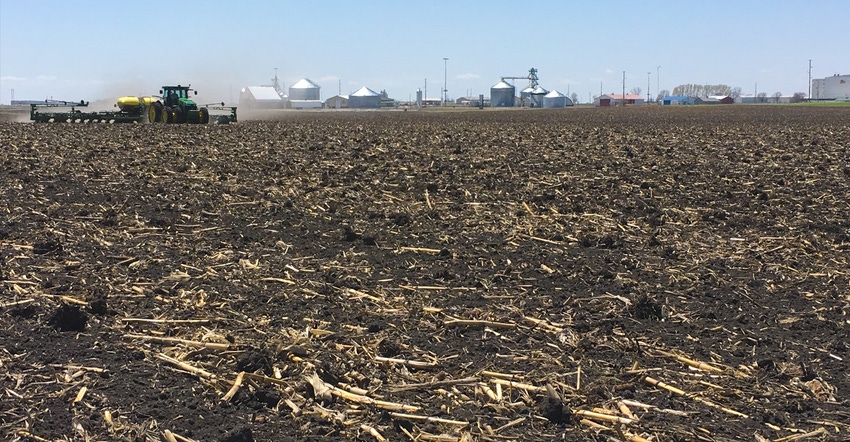August 26, 2018

The field demonstrations draw plenty of Farm Progress Show attendees to the event and out into the field. And while most visitors may be watching combines going through the field, they may also want to get a closer look at how the crop looks at ground level.
"If you want to see what a stand looks like behind an ExactEmerge planter, look down," advises David Moline, territory customer support manager for central Iowa, John Deere. "They'll be able to see how the planter worked."
The machine that rolled into the field demo area to lay in the 2018 crop was a John Deere 1775NT planter equipped with the ExactEmerge row unit being pulled by a John Deere 8370R tractor. "We used Individual Row Hydraulic Downforce that reacts quickly on an individual row basis to changing soil conditions supporting increased ground contact, which can lead to improved seed depth consistency," Moline says. "And the planter had pneumatically controlled row cleaners, and pneumatically controlled closing wheels, which are easy to adjust."
The planter was also equipped with the frame weight distribution option, allowing it to distribute weight evenly across the width of the toolbar. And in the cab, the operator had access to the latest tech as well, such as the SeedStar 4 HP monitor and control system run on the Generation IV 4600 Display on the armrest of the 8370R tractor. In addition, the Connect Mobile app was used on an iPad, which provided row-level information about planting quality going through the field.
"With that technology, we have both real-time data and maps of each row's performance on actual population, seed singulation, seed spacing, ride quality, and ground contact" Moline explains. "We map by the row how much hydraulic downforce was being applied at any given point in the field too."
This information can help farmers determine what's happening in harvest yield maps, too. "We tell the planter how much force we want on the gauge wheels and once we figure out what the setting is for a good seed trench, the system auto-adjusts to that," he says. "You've always got the perfect seed trench for planting."
Every bit of the planting process was mapped by the system, too, including ride quality. And there's the variety map. There is one drawback for that as-planted information in the Farm Progress Show field: harvest data collection. "That's a problem," Moline admits, knowing that demonstration fields are harvested by a wide range of combines of different pedigrees going through the field, so getting matchable harvest data is a challenge.
What about planting speed?
While harvest data may not be available, the system captures other data, such as information the sprayer can use in-season to match up to field needs. "We can run a split screen with a variety on one side and the yield for that variety on the other side," he says. "We'll have that on the Connect Mobile app on the iPad in the combine demo, we just won't have yield data for the whole field."
This is the third time that an ExactEmerge planter has been used at the Boone FPS site, the first year being 2014. It was an early location for one of the first high-speed planters that John Deere marketed, and it showed then that the product works.
For that new-model 2018 planter with its precision-ag tools connected, the machine was moving through the field at a good clip. "We can generate a speed map with the system as well, and for the outside two rounds in the field — the headlands — we moved at about 4.5-6 mph," Moline says. "That's mainly because I don't want to get the planter into the fence."
Once a field was opened up, most of it was planted at about 9 mph, depending on field size and shape, Moline says. "For the north field that will be used for Day 2 and Day 3 demonstrations, a large portion of that was planted at 10 mph."
The other two fields for Day 1 demonstrations included an 80-acre parcel that was planted the short way. "It's hard to get wound up, and by the time you're wound up you're slowing down again," he explains. "It seemed like the best speed there was 9 mph." Given that this is at least a 50% boost over a traditional planter, productivity goes up with the system.
Moline has seen five springs with the ExactEmerge planter, and he recalls that there were a lot of skeptics when the system was introduced. But with demonstration units in the field, the technology has performed. "We've proven that it does work and as we've added some of the other technology, and hydraulic downforce, that really makes that planter shine," he sa
About the Author(s)
You May Also Like






